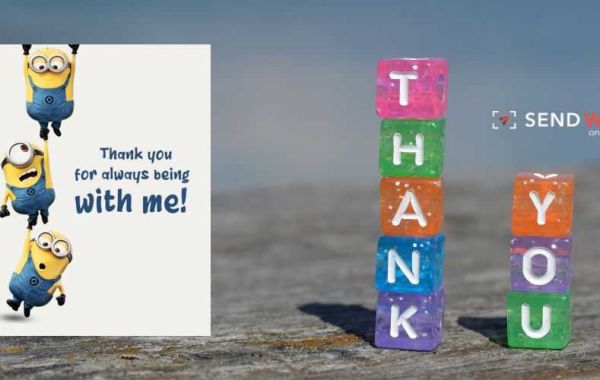Introduction:
In the era of digital communication, the traditional practice of sending thank you cards remains a cherished way to express gratitude. However, with evolving design trends and changing communication methods, thank you cards have also adapted to the modern age. In this article, we will explore the modern trends in thank you card design and communication, highlighting innovative approaches that add a contemporary touch to this timeless tradition.
Minimalist and Clean Designs:
One of the prominent trends in modern thank you card design is a shift towards minimalist and clean aesthetics. Simple yet elegant designs with ample white space, sleek typography, and understated graphics create a sophisticated and visually appealing look. Minimalist designs allow the message of gratitude to take center stage, providing a sense of clarity and focus.
Hand-Lettering and Calligraphy:
In recent years, there has been a resurgence of interest in hand-lettering and calligraphy. Many people appreciate the authenticity and personal touch that hand-drawn typography brings to thank you cards. Hand-lettered designs convey a sense of craftsmanship and individuality, making each card unique and special. From whimsical styles to elegant scripts, hand-lettering adds a touch of artistry to modern thank you cards.
Eco-Friendly and Sustainable Materials:
With increasing environmental awareness, there is a growing demand for eco-friendly and sustainable materials in all aspects of life, including thank you cards. Modern trends emphasize the use of recycled paper, biodegradable inks, and sustainable printing practices. These choices not only reduce environmental impact but also align with the values of gratitude, showing appreciation for the planet as well.
Interactive and Multifunctional Cards:
Innovative designs have introduced interactive and multifunctional elements to thank you cards. This includes cards with detachable elements like bookmarks, postcards, or small gifts that the recipient can keep as a memento. Such interactive features make the thank you card an experience in itself, engaging the recipient and adding an element of surprise and delight.
Incorporation of Technology:
While thank you cards are traditionally physical, there is a growing trend of incorporating technology into their design and communication. QR codes, for example, can be added to the card, leading the recipient to a personalized video message or a digital photo album. This blend of physical and digital elements adds a modern touchto the traditional thank you card, allowing for a more immersive and interactive experience.
Customization and Personalization:
Modern thank you card trends emphasize customization and personalization to create a more meaningful connection. From customizable designs that allow for the inclusion of personal photos or messages to tailored themes that reflect the recipient's interests or hobbies, these cards are designed to make the recipient feel truly seen and appreciated.
Visit to:- Get well card
Integrating Social Media:
In today's digital age, social media platforms play a significant role in communication. Modern thank you cards often integrate social media elements, such as including hashtags related to the occasion or encouraging recipients to share their gratitude on their social media profiles. This approach extends the reach of the thank you message and allows others to join in the celebration of gratitude.
Expressive and Emotionally-driven Messages:
Alongside design trends, communication styles in thank you cards have also evolved. Modern thank you cards often feature expressive and emotionally-driven messages. Rather than simply stating "thank you," these messages delve deeper, expressing genuine emotions, and highlighting the impact the recipient has had on the sender's life. This shift towards more heartfelt and personal messages creates a stronger emotional connection.
Digital Thank You Cards:
While physical thank you cards still hold a special place, digital thank you cards have gained popularity due to their convenience and immediacy. With various online platforms and websites, individuals can design and send personalized digital thank you cards via email or social media. Digital cards offer the advantage of real-time delivery, allowing for instant gratitude expression.
Thank You Card Collaborations:
Collaborative thank you cards have emerged as a modern trend, especially for group gestures of appreciation. Instead of a single sender, multiple individuals can contribute their messages and signatures to a collective thank you card. This collaborative approach fosters a sense of unity and amplifies the gratitude expressed.
Geometric Patterns and Abstract Designs:
Geometric patterns and abstract designs have gained popularity in modern thank you card design. These patterns can add a touch of visual interest and contemporary flair to the card. From bold and vibrant geometric shapes to subtle and intricate abstract motifs, these designs create a visually striking and modern aesthetic.
Mixed Media and Collage:
Another trend in thank you card design is the use of mixed media and collage techniques. Incorporating various materials such as fabric, ribbons, washi tape, or even cut-out images from magazines can create a unique and textured look. Mixed media and collage techniques allow for endless creativity and customization, resulting in visually captivating and one-of-a-kind thank you cards.
Conclusion:
As times change, so do the trends in free thank you ecards design and communication. Modern thank you cards embrace minimalist aesthetics, hand-lettering, eco-friendly materials, interactive elements, technology integration, customization, and expressive messages. From physical cards to digital alternatives, the art of expressing gratitude continues to evolve while retaining its core purpose of conveying appreciation. So, whether you opt for a sleek and simple design or an interactive digital format, the important thing is to embrace these modern trends and let your gratitude shine through in a thoughtful and contemporary way.







